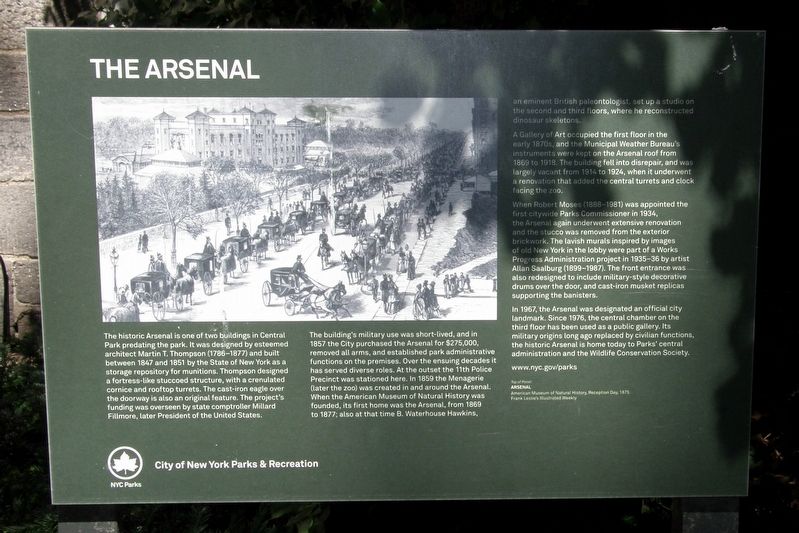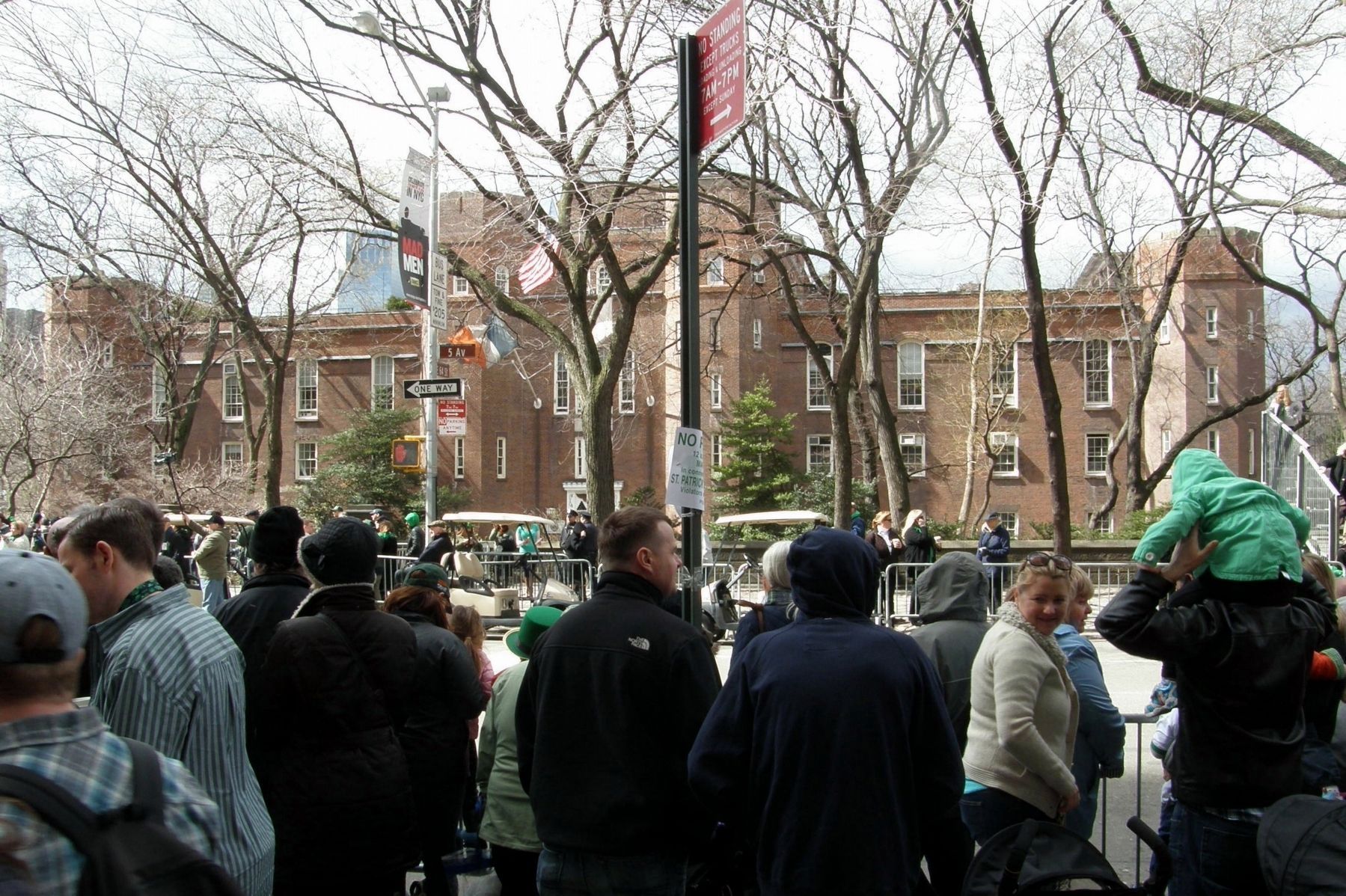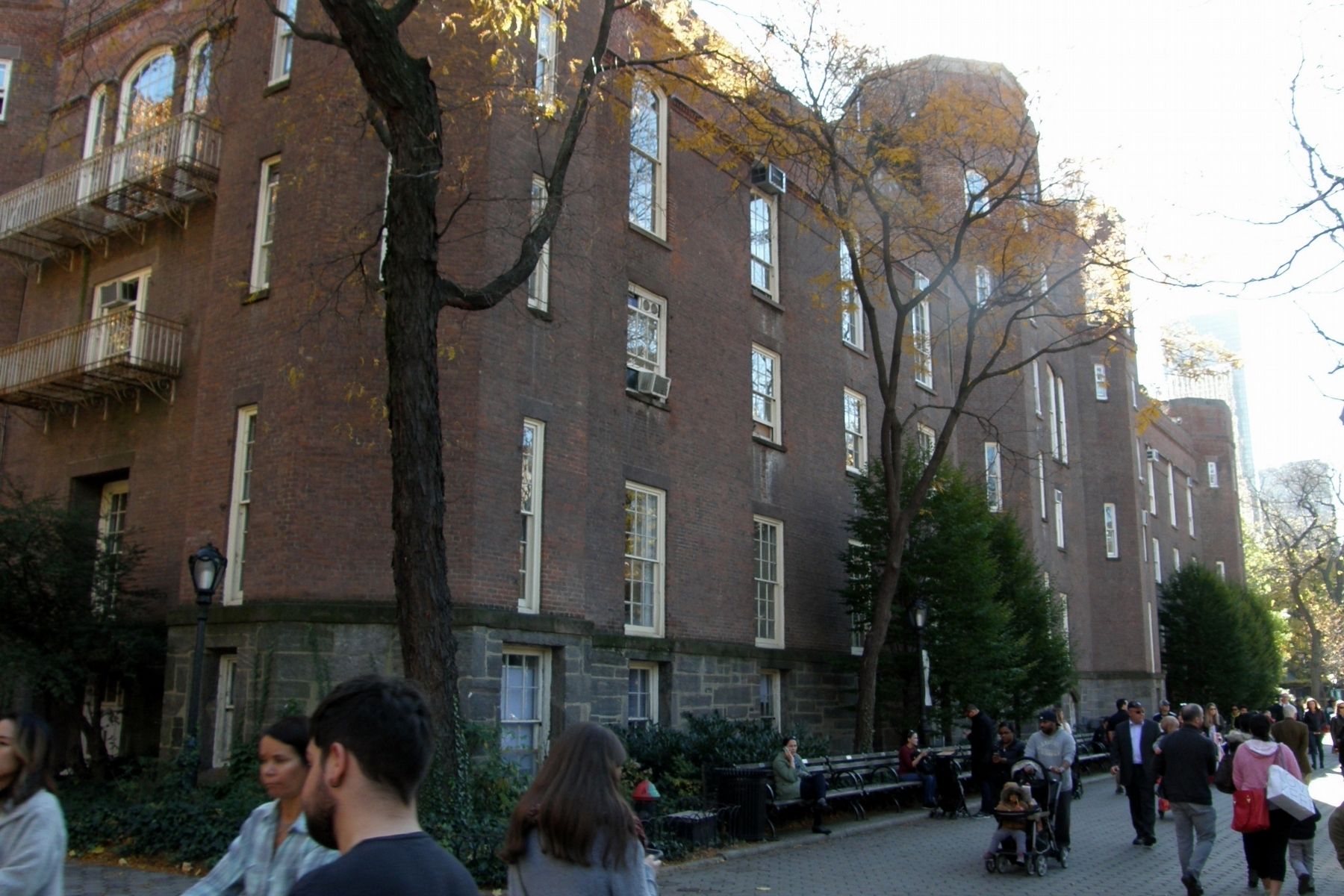Central Park West Historic District in Manhattan in New York County, New York — The American Northeast (Mid-Atlantic)
The Arsenal
The historic Arsenal is one of two buildings in Central Park predating the park. It was designed by esteemed architect Martin T. Thompson (1786-1877) and built between 1847 and 1851 by the State of New York as a storage repository for the storage of munitions. Thompson designed a fortress-like stuccoed structure, with a crenulated cornice and rooftop turrets. The cast-iron eagle over the doorway is also an original feature. The project’s funding was overseen by state Comptroller Millard Fillmore, later President of the United States.
The building’s military use was short-lived, and in 1857 the City purchased the Arsenal for $275,000, removed all arms, and established park administrative functions on the premises. Over the ensuing decades it has served diverse roles. At the outset the 11th Police Precinct was stationed here. In 1859 the Menagerie (later the zoo) was created in and around the Arsenal. When the American Museum of Natural History was founded, its first home was the Arsenal, from 1869 to 1877; also at that time B. Waterhouse Hawkins, an eminent British paleontologist, set up a studio of the second and third floors, where he reconstructed dinosaur skeletons.
A Gallery of Art occupied the first floor in the early 1870s, and the Municipal Weather Bureau’s instruments were kept on the Arsenal roof from 1869 to 1918. The building fell into disrepair, and was largely vacant from 1914 to 1924, when it underwent a renovation that added the central turrets and clock facing the zoo.
When Robert Moses (1888-1981) was appointed the first citywide Parks Commissioner in 1934, the Arsenal again underwent extensive renovation and the stucco was removed from the exterior brickwork. The lavish murals inspired by images of old New York in the lobby were part of a Works Progress Administration project in 1935-36 by artist Allan Sallburg (1899-1987). The front entrance was also redesigned to include military-style decorative drums over the door, and cast-iron musket replicas supporting the bannisters.
In 1967, the Arsenal was designated an official city landmark. Since 1976, the central chamber on the third floor has been used as a public gallery. Its military origins long ago replaced by civilian functions, the historic Arsenal is home today to Parks’ central administration and Wildlife Conservation Society.
Erected by City of New York Parks & Recreation.
Topics and series. This historical marker is listed in these topic lists: Architecture • Entertainment • Paleontology
• Parks & Recreational Areas. In addition, it is included in the Former U.S. Presidents: #13 Millard Fillmore, and the NYC Parks series lists. A significant historical year for this entry is 1847.
Location. 40° 46.058′ N, 73° 58.276′ W. Marker is in Manhattan, New York, in New York County. It is in the Central Park West Historic District. Marker can be reached from Fifth Avenue near East 64th Street. Touch for map. Marker is in this post office area: New York NY 10065, United States of America. Touch for directions.
Other nearby markers. At least 8 other markers are within walking distance of this marker. A different marker also named The Arsenal (here, next to this marker); Native New Yorkers (about 300 feet away, measured in a direct line); Studying Grizzly Clues / From Clues to Conservation (about 300 feet away); Meet Our Bears (about 300 feet away); Central Park Wildlife Conservation Center (about 300 feet away); Lehman Gates (about 300 feet away); Temple Emanu-el (about 400 feet away); a different marker also named Lehman Gates (about 400 feet away). Touch for a list and map of all markers in Manhattan.
Regarding The Arsenal. The building is included in the AIA (American Institute of Architecture) Guide to New York City, Fifth Edition.
Also see . . . The 1851 Central Park Arsenal. "Daytonian in Manhattan" entry. (Submitted on April 12, 2020, by Larry Gertner of New York, New York.)
Credits. This page was last revised on January 31, 2023. It was originally submitted on November 11, 2018, by Larry Gertner of New York, New York. This page has been viewed 214 times since then and 16 times this year. Last updated on July 23, 2019, by Larry Gertner of New York, New York. Photos: 1, 2, 3. submitted on November 11, 2018, by Larry Gertner of New York, New York. • Bill Pfingsten was the editor who published this page.


